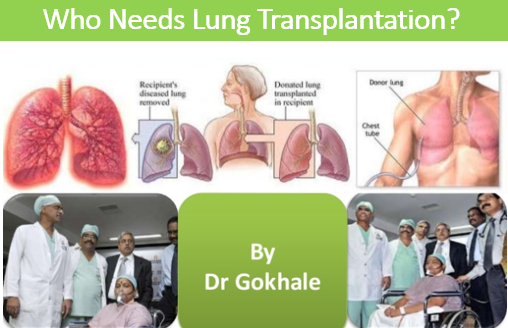All of us have two lungs in the chest-one on the right side and one on the left side. When we breathe air into the lungs- they allow oxygen from outside to enter into blood and allow carbon-di-oxide from blood to come out into the air. This way we get enough oxygen for the body to work and remove carbon-di-oxide produced in the body. Sometimes these lungs can get damaged by various conditions like Chronic obstructive lung disease (seen usually in smokers and those with bronchial asthma), fibrosis of lungs, following some infections in lungs, due to high pressure in the blood vessels in the lungs (Primary pulmonary hypertension) and sometimes due to genetic problems (cystic fibrosis). When they are damaged, there will not be enough oxygen in the blood and patient gets breathless and cannot walk or do their routine activities. They need oxygen supplementation with oxygen cylinders or by machines. When the disease is severe, the only option for them is “Lung Transplantation”.
Lung transplantation means- removing the destroyed lungs and replacing with a lung from a human donor, usually a brain dead person. We may do single lung transplantation or change both lungs depending on the condition of the patient. Infections need bilateral lung transplantation. Others can be managed by single lung transplantation most of the times.
TIMING OF LUNG TRANSPLANTATION:
The timing of Lung Transplantation is based primarily on clinical judgment. The physiologic severity, the rate of progression and the natural history of the disease must be considered. Although prognostic factors have been identified for some lung disease, definite prognostic indices are not available and the clinical course of any individual patient is often unpredictable. Thus a constellation of data must be assessed but the final decision must take into account the individual circumstances of each patient. The multidisciplinary team discussion and follow-up in pre-transplant clinic by pulmonology is essential.
GENERAL GUIDELINES:
1.Clinically and physiologically severe disease.
2.Medical therapy ineffective or unavailable.
3.Limited life expectancy, usually less than 2-3 years
4.Ambulatory with rehabilitation potential.
5.Acceptable nutritional status, usually 80-120% of ideal body weight.
6.Satisfactory physiological profile and support system.
7.Adequate coverage for the procedure and post transplantation care.
WHEN WE CANNOT OFFER LUNG TRANSPLANTATION?
At the same time, all the patients with end stage lung disease are not suitable for lung transplantation.
ABSOLUTE CONTRAINDICATIONS: This means, patients with these problems are not fit for lung transplantation.
1.Drug or alcohol dependency
2.Acutely ill or unstable clinical status
3.Uncontrolled or untreatable pulmonary or extrapulmonary infection.
4.Uncured neoplasm: active cancers within past 2 yr except basal and squamous cell carcinoma of skin. Requires >5yr remission for:
Extracapsular renal cell
Breast >stage2
Colon >Dukes
Melanoma> level III
5.Significant dysfunction of other vital organs, especially liver, kidney and central nervous system.
6.Significant coronary disease or left ventricular dysfunction.
7.Active cigarette smoking (patients must abstain from any form of nicotine for a minimum of six months)
8.Unresolvable psychosocial problems or noncompliance with medical management
9.HIV infection
10.Hep B S Ag positivity and hepatitis C with biopsy proven liver disease .
RELATIVE CONTRAINDICATIONS: This means, depending on the condition of the patient and experience of the surgical team, the patients with these can be considered for Lung Transplantation.
1. Atherosclerotic heart disease
2. Diabetes mellitus
3. Renal failure and /or hepatic abnormalities
4. Decreased ambulatory capacity
5. Chronic infectious lung disease
6. Obesity/cachexia
7. Systemic disease such as SLE
8. Pneumonia, recent or unresolved pulmonary infection.
9. Mycobacterial and fungal infection
10.Mechanical ventilation
11.Multidrug resistant bacteria.














